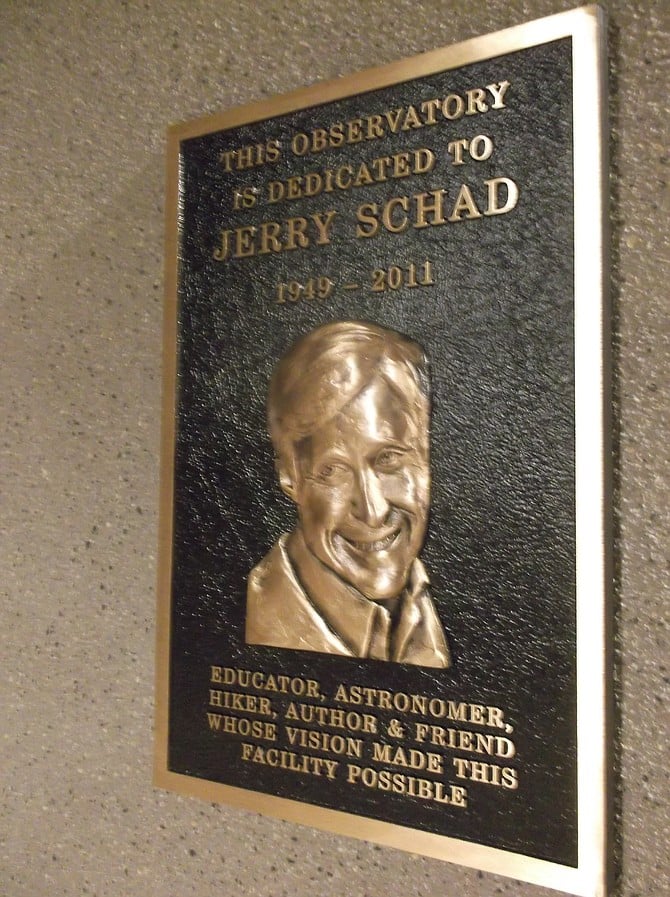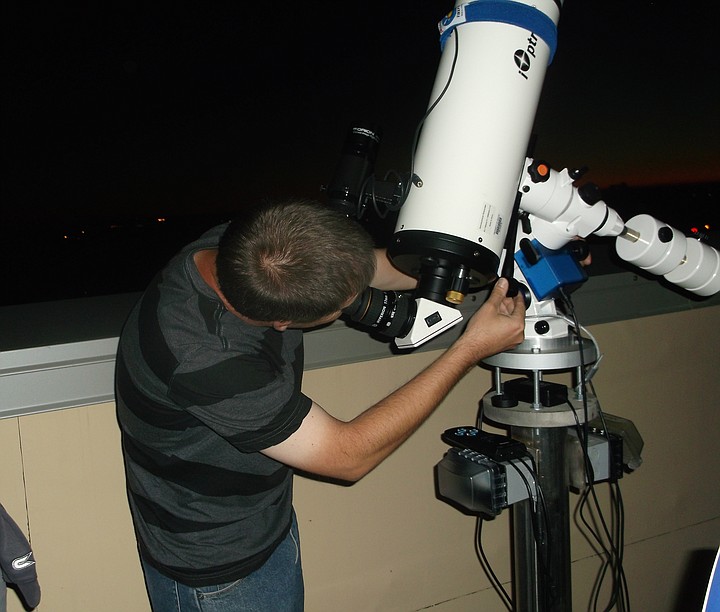 Facebook
Facebook
 X
X
 Instagram
Instagram
 TikTok
TikTok
 Youtube
Youtube

Colleagues and friends of Jerry Schad, astronomer, teacher, and author of San Diego's best hiking guide, assembled at Mesa College Thursday (November 18) to dedicate the Jerry Schad Observatory atop the Mathematics and Natural Sciences building.
"He would have loved to see this," said Bill Brothers, a biology professor who worked with Schad for 15 years. "Without Jerry, we wouldn't have this area. It’s all for the students and that's what he was about."
On Thursday, the fledgling observatory had telescopes set up to pick out wonders of the night sky — and professors to explain them. For example, one telescope was locked in on a binary star, and a professor explained that a binary star is two stars that form in one cloud of gas, a stronger one and a weaker twin that are forever attached and spin around each other.

A maze of viewing spots, the observatory is on the roof — the fifth level — of the building finished in 2013, at a cost of about $110 million. It holds permanent mounts for telescopes (three in use Thursday) and a host of other sky-viewing equipment. It is used for classes, projects and, coming soon, star parties and public gatherings.
Schad was part of the “away team,” a group of professors who dreamed up a math-sciences building that would dissolve barriers between disciplines and between students and professors. The project, designed by architects with guidance from the teachers, won an Orchid prize for landscape architecture from the San Diego Architectural Foundation this year.
The dedication was deeply personal for the professors. They worked with Schad, walked with him and took big groups of students camping in Anza-Borrego Desert State Park so they could see the night sky without city lights blurring and obscuring.
"Professor Schad would talk about the stars, planets, and galaxies and he could go for hours," his widow, Peg Reiter, said. "The thing Jerry loved best of all was teaching."
Schad, who died in 2011, wrote Afoot and Afield in San Diego, which he updated many times. (His guidebooks introduced this writer to some of the best and most interesting trails in San Diego — hikes that I still enjoy.) From 1993 until his death, he worked on the weekly “Roam-O-Rama” column in the Reader, which transformed many curious readers into hardcore hikers.
He also wrote his own obituary while he was dying of kidney cancer, saying his life was full of "discovery and adventure."
Best friend Sina Sadjadi, also a professor, remembered visiting Jerry in his last days, when he was in great pain.
"He found out I didn't have a retirement plan and for the next two hours he was writing how I should set up my retirement, how much I should put in that account, how I should invest the money," Sadjadi said. "He was in so much pain and he was worried about my future."
There weren't any tears at the dedication. Instead, the feeling was of quiet pride in carrying forward the work of this man, this friend, this colleague who'd done much to get people moving in a good direction. Continuing his work is the best possible honor, Sadjadi said as he slipped away to go teach waiting students. "Jerry was like a comet, a rare and bright light that passed through this time and space," his sister, Laurie Schad, wrote in a letter.


Colleagues and friends of Jerry Schad, astronomer, teacher, and author of San Diego's best hiking guide, assembled at Mesa College Thursday (November 18) to dedicate the Jerry Schad Observatory atop the Mathematics and Natural Sciences building.
"He would have loved to see this," said Bill Brothers, a biology professor who worked with Schad for 15 years. "Without Jerry, we wouldn't have this area. It’s all for the students and that's what he was about."
On Thursday, the fledgling observatory had telescopes set up to pick out wonders of the night sky — and professors to explain them. For example, one telescope was locked in on a binary star, and a professor explained that a binary star is two stars that form in one cloud of gas, a stronger one and a weaker twin that are forever attached and spin around each other.

A maze of viewing spots, the observatory is on the roof — the fifth level — of the building finished in 2013, at a cost of about $110 million. It holds permanent mounts for telescopes (three in use Thursday) and a host of other sky-viewing equipment. It is used for classes, projects and, coming soon, star parties and public gatherings.
Schad was part of the “away team,” a group of professors who dreamed up a math-sciences building that would dissolve barriers between disciplines and between students and professors. The project, designed by architects with guidance from the teachers, won an Orchid prize for landscape architecture from the San Diego Architectural Foundation this year.
The dedication was deeply personal for the professors. They worked with Schad, walked with him and took big groups of students camping in Anza-Borrego Desert State Park so they could see the night sky without city lights blurring and obscuring.
"Professor Schad would talk about the stars, planets, and galaxies and he could go for hours," his widow, Peg Reiter, said. "The thing Jerry loved best of all was teaching."
Schad, who died in 2011, wrote Afoot and Afield in San Diego, which he updated many times. (His guidebooks introduced this writer to some of the best and most interesting trails in San Diego — hikes that I still enjoy.) From 1993 until his death, he worked on the weekly “Roam-O-Rama” column in the Reader, which transformed many curious readers into hardcore hikers.
He also wrote his own obituary while he was dying of kidney cancer, saying his life was full of "discovery and adventure."
Best friend Sina Sadjadi, also a professor, remembered visiting Jerry in his last days, when he was in great pain.
"He found out I didn't have a retirement plan and for the next two hours he was writing how I should set up my retirement, how much I should put in that account, how I should invest the money," Sadjadi said. "He was in so much pain and he was worried about my future."
There weren't any tears at the dedication. Instead, the feeling was of quiet pride in carrying forward the work of this man, this friend, this colleague who'd done much to get people moving in a good direction. Continuing his work is the best possible honor, Sadjadi said as he slipped away to go teach waiting students. "Jerry was like a comet, a rare and bright light that passed through this time and space," his sister, Laurie Schad, wrote in a letter.
Comments